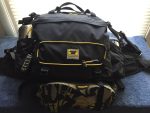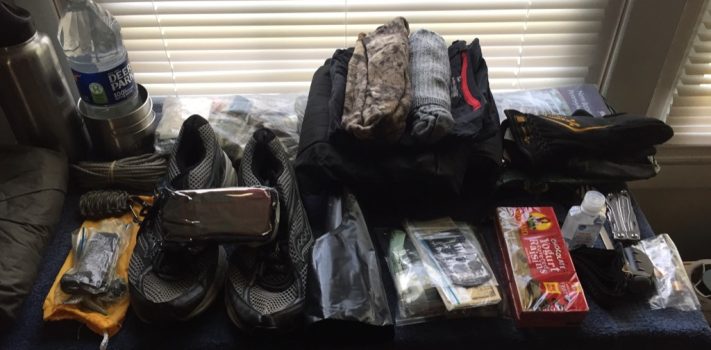Anyone who leaves home should bring a Get Home bag with them. We regularly hear of incidents in which people leave home expecting a 30-minute jaunt in their climate-controlled vehicle only to find themselves in a grim, hours-long ordeal without even a bottle of water to tide them over. In some instances the individuals could simply pull over to the side of the road and walk home, but they are wearing high-heeled shoes and have no coat: after all, they had no intention of doing any walking nor did they expect to be out of their warm vehicle any longer than it takes to walk into a warm building.
Precisely what “getting home” entails depends on each person. I am blessed to work approximately 3 miles from where I live when I am not working at home. In the event that I had to walk home suitable outerwear, comfortable shoes, and a bottle of water would usually be adequate for the task. However, like most people, I am sometimes much farther from home. It may take several days to get home if I am required to walk and I will need some basic supplies to make that feasible.
The typical solution is some sort of rucksack. This may take the form of a military-style bag or it may simply be a book bag. In most cases it involves a bag that is suspended from the shoulders (or, worse still, a sling pack that is suspended from one shoulder). Anyone who has done any significant amount of backpacking knows how painful that can be if the bag is more than a few pounds. The only people who plan to carry a 40-pound “get home” bag on their shoulders for 10 miles (and then do it again the next day and the day after) are soldiers and people who have never actually done it.
In this article, I’m suggesting an alternative: the lumbar pack. The photo below shows my Get Home Bag: it is a Mountainsmith Day model lumbar pack, featuring a wide, heavily padded hip belt together with the optional shoulder straps. The shoulder straps only stabilize the load; the weight of the pack rests on the hips.
 Lumbar packs are available in various sizes but are typically smaller than most backpacks: the Day model holds about 11 liters. While it is feasible to carry a jacket with the external bungee cord arrangement and items could be strapped to the bottom or the top, the pack provides modest capacity and, frankly, that can be a good thing. There is a philosophy that one should over-pack and then discard items en route, as needed. In my humble opinion, this is unwise advice that may produce serious injury due to a fall or excessive wear and tear on our joints just when we need our bodies to do the extraordinary. I strongly advocate for choosing carefully the items that are necessary to get home and leaving excess weight behind from the outset.
Lumbar packs are available in various sizes but are typically smaller than most backpacks: the Day model holds about 11 liters. While it is feasible to carry a jacket with the external bungee cord arrangement and items could be strapped to the bottom or the top, the pack provides modest capacity and, frankly, that can be a good thing. There is a philosophy that one should over-pack and then discard items en route, as needed. In my humble opinion, this is unwise advice that may produce serious injury due to a fall or excessive wear and tear on our joints just when we need our bodies to do the extraordinary. I strongly advocate for choosing carefully the items that are necessary to get home and leaving excess weight behind from the outset.
Before considering the contents of the Get Home Bag it is necessary to account for my Everyday Carry (EDC): these items will supplement the equipment found in the bag. On any given day there are a number of useful items on my person: for example, I will have my car and house keys along with a key ring holder that contains a mini-Bic lighter. In my pocket will be my most useful tool, a Victorinox Midnite Manager that includes a retractable pen (the most useful tool of all), a small blade, small but useful scissors, a Phillips screwdriver, small flat blade screwdriver with nail file, and a flashlight that is bright enough to illuminate a key slot in the dark. I also carry a separate flashlight (I can’t imagine how I managed without a flashlight on my person for so many years) such as the OLight i3T EOS that provides bright, long-lasting light on a single AAA battery as well as a clip that attaches to a ball cap for hands-free use.
I will always have my wallet with a few business cards for notes and some cash (always have cash with you), a handkerchief (once upon a time a man always carried a handkerchief; imagine all of the useful emergency applications from bandaging to carrying), some reading glasses, and my carry handgun (usually, a SIG P365). Add to this my cell phone with a number of useful functions, even if the grid is down and a multi-tool (a Leatherman CX Skeletool: I don’t carry a separate knife as the Skeletool has better than usual-Leatherman-quality steel for the blade) on a money belt holding more cash (always have cash with you).
 With these useful EDC items in mind, the photograph on the right shows the contents of my Get Home Bag. Of highest priority are water, footwear, and clothing. In addition to a liter of ready water I have a stainless steel cup, a single-wall stainless steel water bottle (both of which are suitable for boiling water), a water filter housed inside the water bottle and a Silcock key to enable access to the outdoor spigots of commercial buildings.
With these useful EDC items in mind, the photograph on the right shows the contents of my Get Home Bag. Of highest priority are water, footwear, and clothing. In addition to a liter of ready water I have a stainless steel cup, a single-wall stainless steel water bottle (both of which are suitable for boiling water), a water filter housed inside the water bottle and a Silcock key to enable access to the outdoor spigots of commercial buildings.
I generally wear practical footwear, but a well-worn and comfortable pair of walking shoes is included with the bag. I carry a hooded rain jacket, rain pants, and a warm fleece balaclava (better than a hat: it also retains heat from the neck and can be worn as a neck gaiter when appropriate) to provide maximum weather protection for minimum weight. A spare pair of socks, t-shirt, and bandana packed in a dry bag (a useful item on it’s own) round out the extra clothing. Mechanics gloves and sunglasses are included as well.
It is worth noting what is not in the bag. An elaborate shelter arrangement such as a tent or bivy is absent: out-buildings, garden sheds, deer blinds, and other make-shift buildings abound where I live and travel. A tarp, two contractor garbage bags, and some cordage should suffice for shelter. I prefer the survival paracord: in addition to the paracord there is a strand of fishing line, flammable jute, and copper wire woven into the cord (a small container including a few fish hooks provide a supplemental food capability with miniscule weight). I also plan to add a lock pick set and acquire this useful skill: many public parks have service buildings that are locked but not monitored as they have nothing of great value inside. The ability to discreetly access these buildings will provide a relatively secure shelter superior to a tent in an emergency.
Similarly, there is no stove or fuel: I could start a fire and use the cup or water bottle, but the goal is to travel light and fast. Trail-mix, nuts, and other high-calorie foods that do not require preparation will provide calories for several days. Tactical items such as chem lights are not included: I cannot imagine how such a single-use item would be worth the weight when the objective is simply to get home quickly.
Supplementing my Everyday Carry are spare magazines for my carry handgun (if conditions warrant I can upgrade to a more effective personal defense capability) and batteries that fit both the headlamp included in the bag and my EDC flashlight. A small radio/flashlight that can be charged by solar or hand crank provides information including weather reports and light redundancy: the radio is stored in a mylar bag to provide EMP protection. In addition to my EDC multi-tool a Leatherman Sidekick is included in the bag to provide a basic tool capability.
Additional cash is included in the bag (always have cash with you): there are many scenarios in which electronic payment is not an option but supplies can be purchased with cash or someone will provide a ride for $20 when they would not do so out of the goodness of their heart. Even in the early days of an economic collapse when you and I know paper money is worthless it will hold residual value for many: we may be able to purchase a bicycle for 200 worthless dollars that will speed us in getting home.
An assortment of useful items such as Ibuprofen (highly recommended for the inevitable inflamed joints and sore muscles), an Ace bandage to shore up a cranky knee or ankle, a spare pair of reading glasses (with duct tape wrapped around the case), insect repellant, and fire making supplies are enclosed in a plastic bag. I highly recommend a small bottle of alcohol-based hand sanitizer: in addition to the antiseptic properties, the alcohol provides a very effective fire starter. A titanium spork will go with the stainless steel cup (you never know where you might come upon food and need a utensil). Paper maps housed in a plastic bag are also a must, because smartphones may not work and alternative routes to avoid dangers such as civil unrest may be in order. Hand wipes are useful in a variety of ways (if you know what I mean).
A trauma kit including a tourniquet, QuickClot, chest seal, medical gloves, and trauma shears is in the bag, but this is primarily to have it available for a medical emergency during ordinary times: I do not expect to need it to get home. This brings up another value of the Get Home bag: while I have never had to walk home because an EMP has disabled my vehicle, I have used items from the bag many times in more mundane circumstances. When my infant grandson vomited all over my shirt, I had a clean shirt in the bag. When an extraordinary bargain became available at the gun show I had additional cash available to make it happen. And simply having a bottle of water can be a great relief.
IMPORTANT NOTE TO SELF: Always replace any items you use from the bag!
Everyone’s circumstances are different and your circumstances may make the smaller lumbar pack impractical. If so, upgrade to a suitable size backpack with a functioning hip suspension. However, the principle remains the same: it is prudent to prepare for the loss of modern tools we come to rely upon including vehicular transportation by assembling the means to be self-sufficient. It is also prudent to test our preparations to find out whether our plans are feasible. A “Get Home” bag is a necessity, a bag that carries on the hips is a practical necessity if we plan to do any significant amount of walking, and a Get Home Bag to supplement our Everyday Carry is a regular help in normal times.










